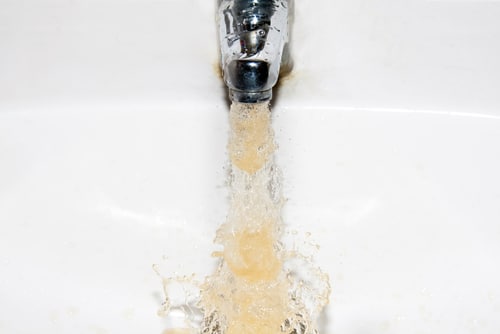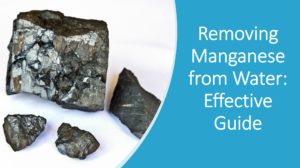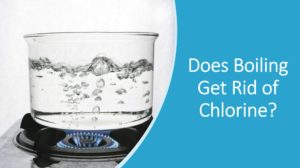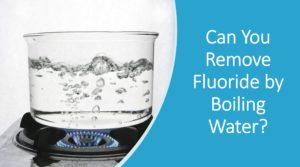Why is my water yellow? If your water tastes or smells strange, has a yellowish color, or if you have rust-colored stains in your tub and sink, or on clothes and dishes that have been soaked in your well water, your water probably contains an excess of certain minerals or compounds.
You should get your water tested by either hiring a professional service or purchasing an online DIY water test kit.
The Reason for Yellow Water
Yellow water may be caused by tannins, compounds found in the wood, leaves, and fruit of many plants in nature. Tannins aren’t harmful to you, but they have a bitter taste, and yellow water is ugly to look at.
Another common cause of yellow water is iron or manganese that finds its way onto the water. Well water that comes out of the tap yellow, orange, or red probably contains too much iron.

Is Yellow Water Safe to Drink?
Usually, discolored water doesn’t pose an immediate risk to your health. Since your body absorbs iron naturally, you don’t have to worry. but there are better ways to get your daily allotment of minerals than by drinking weird-colored water.
Showering in yellow water isn’t dangerous, but you shouldn’t make a habit of it. While fixing your yellow water problem, as long as you aren’t exposed to it long-term, you will be fine. If you routinely bathe in yellow water, though, it can dry out your skin and cause hair and scalp problems.
Iron Water Damage
Too much iron in your well not only discolors the water, but can damage your plumbing, sinks, and any other items around your house that come into contact with the well water. Plus, iron water tastes metallic and smells weird. You don’t want it around if you can help it.
Iron water can also cause clogging in your appliances and plumbing. This happens because the sediment from certain kinds of iron can pile up in places like your washing machine, your drains, and your well itself. If this happens, you have a lot more to deal with than just a funny taste.
If you’ve dealt with iron water before, you’ve probably noticed rust-colored stains on your laundry, dishes, and any appliance that connects to your plumbing line or contains water on a regular basis. This includes sinks, bathtubs, and toilets. A rust-colored ring around your tub or sink is a warning sign of iron in your water.
If your sprinkler system uses well water, the water can stain your sidewalk and driveway. The stains can be yellow, red, or rust colored and are very difficult to remove. It’s best to deal with yellow well water as soon as possible to prevent any further lasting damage to your property.
How Does Iron Get Into the Water?
The water in your well is groundwater, rainfall that soaks into the soil and finds its way to aquifers. Aquifers are water storage areas below the ground that you can tap into when digging or drilling your well.
After a rainfall, the groundwater soaks into the soil and makes its way downward. En route to aquifers, the water comes into contact with rocks and mineral deposits. Some of these rocks and mineral deposits contain iron, and the water dissolves the iron and carries it to your well. If you have iron in your water, this is probably from lead-bearing rocks or minerals in your soil.
How to Treat Iron Water
Treatment of iron water depends on what kind of iron is in your water. Have the water tested to determine what kind of iron you’re dealing with. Some kinds of iron are more difficult to treat than others, and it’s best if you know from the beginning what you’re dealing with.
Ferric Iron
Ferric iron is an insoluble iron that you can see in the water as soon as you turn on the tap. Water that contains ferric iron will be yellow or rust-colored as it flows into your sink, shower, or out of your sprinklers. The iron has been exposed to oxygen and has become a sediment.
Depending on how bad the problem is, you can use a couple of methods for filtering out the iron. Fortunately, since ferric iron isn’t dissolved in your water, it’s the easiest to remove.
You can use a sediment filter to separate iron from the rest of the water. The water will flow through, but the iron sediment will remain captured in the filter.
Ferrous Iron
Ferrous iron is iron that has dissolved into water and hasn’t been exposed to oxygen yet. If your water comes out of the tap clear and gets discolored after it sits, you are dealing with ferrous iron. You can’t treat this kind of iron with a filter. You will need to use a water softener, which removes ferrous iron from your water through ion exchange.
If you don’t want to install a water softener, you can use an AIV, or air-aspirated filter. This method injects oxygen into the water, which allows the iron to oxidize and become sediment. Basically, you force the ferrous iron to become ferric iron. Once you do this, you can treat it with a filter like any other ferric iron problem.
Well, That’s All
Even though it isn’t immediately dangerous to bathe in and drink yellow well water, it can be both annoying and expensive. Iron water causes ugly damages that are costly and time-consuming to fix. It also creates a prime environment for organisms that can cause you to get sick. If your water is yellow, get it treated as soon as possible.
Before treating your water, test it to find out what is causing the discoloration. When you know what you’re dealing with, whether it be tannins, iron, or another mineral or compound, treating the problem will be a lot easier.







